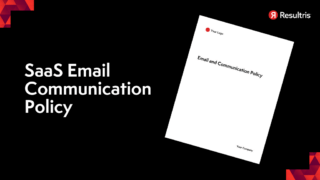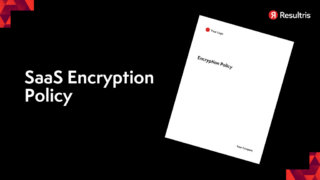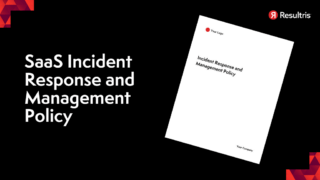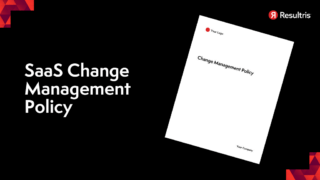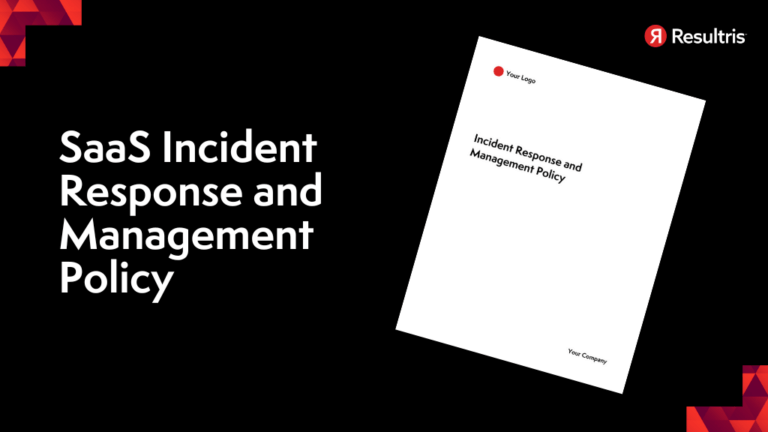
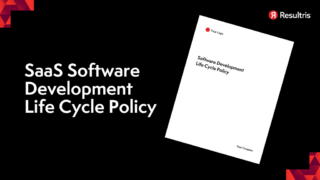
Written by: Tim Eisenhauer
Last updated:

In the fast-paced world of Software as a Service (SaaS), you can’t afford to be unprepared when things go wrong. An effective incident response and management policy is your first line of defense, providing a clear roadmap to navigate any crisis.
Understanding the intricacies of SaaS incident response is not just about recovery; it’s also about resilience. This article will delve into the importance of having a robust policy in place and the key elements that make it effective.
To ensure you’re on the right track, we’ll also touch on SaaS Compliance and Security Best Practices. So, are you ready to fortify your SaaS incident response strategy? Let’s get started.
You’re about to delve deeper into the realm of SaaS Incident Response and Management Policies. Brace yourselves, for you’re threading the path to robust service delivery and all-round functionality.
Let’s shed light on this imperative element.
A SaaS Incident Response and Management Policy, often just termed as the Incident Response Policy (IRP), is a standardized approach that guides software companies in handling breaches or interruptions effectively. Predominantly, it’s a security net ensuring that, when an incident happens, suitable steps are taken promptly – the analysis of the problem, containment, eradication, and subsequent remediation – hence safeguarding the continuation and integrity of business operations.
In the SaaS world, the IRP exemplifies an extensive spectrum. It covers everything from simple software bugs to major service outages, data breaches, and cyberattacks. Every SaaS company – irrespective of its size, tenure in the marketplace, or customer base size – requires such a policy for a proven pathway to incident management.
Access the most pressing reasons for establishing one.
SaaS companies run on data – your data. An IRP helps minimize downtime and curtail data loss, enabling the return to regular operations quickly. Think of it as a life jacket, keeping your company afloat in the choppy tides of mishaps.
Moreover, having an IRP bolsters customers’ trust. People entrust you with their data. Demonstrating a sturdy approach to incidents proves to them, you’re equipped to handle their data responsibly and react quickly if things go sideways.
Another important aspect – regulatory compliance. Different sectors face different regulatory expectations when it comes to data handling and incident reporting. A well-structured IRP not only complies with regulations but also assists in keeping promised service levels intact – and there you have it, a resilient brand is born.
Having an incident response plan is crucial, but knowing its components makes it effective. Here’s what you’re looking for.
You’ll find it’s easier to manage any crisis, be it security breaches or service outages, once they’re classified and prioritized. This is not a one-size-fits-all effort, as each incident carries a unique impact and risk factor.
Different types of incidents, like security breaches or service outages, require different responses. Recognizing these distinct incidents enables a swift and relevant response, reducing unnecessary downtime.
Incident prioritization depends on severity levels and associated response times. Prioritizing incidents on a seriousness scale ensures that high-risk situations receive immediate attention and appropriate response.
A well-prepared incident response team is the backbone of any response policy. An efficient team should include members with diverse skills to tackle various crisis situations.
Phenomenal incident response policies incorporate efficient detection and reporting systems. It involves setting up detection mechanisms to identify incidents promptly and creating a clear pathway for reporting detected issues.
Once an incident is reported, it’s important to have proven procedures in place to respond and contain the situation. This step involves isolating affected systems and identifying potential threats to minimize further harm.
Learning and improving from the incident is a fundamental aspect of any incident response plan. This process includes returning your systems to normal operation and conducting a thorough post-incident analysis to glean valuable insights and future preventive measures. Remember, the goal is not just to navigate past the crisis but to emerge stronger and more resilient for future ones.
In the heart of any robust SaaS Incident Response and Management Policy, diverse roles exist- each with specific responsibilities. Let’s delve into the various stakeholders involved in such a policy and clarify their roles and obligations.
Executive leadership functions as the incident response overseer. They make key decisions, especially in high-severity situations. Acting as the foundation for formulating and implementing a wide-ranging incident response plan, they allocate resources, establish budgets, and prioritize objectives. They also set forth guidelines for maintaining transparency and compliance amid incidents.
Serving as the first line of defense against incidents, the IT and Security team deals regularly with threats. Their responsibilities extend from regular system monitoring to swift incident identification and classification. They also handle initial response steps, system rectification, data recovery, and establishing preventive measures. Their extensive technical skills and timely preventive actions keep the system secure and incidents at bay.
Your customer support team works as the ‘face’ of the company during an incident. They possess a strong understanding of the product or service, effectively communicating with customers and managing expectations during an incident. While handling immediate customer concerns, they also provide updates and ensure that customers remain well-informed throughout the incident’s management process.
When an incident escalates, the legal and PR teams play imperative roles. The legal team ensures that the organization’s response is compliant with relevant laws, regulations, and contractual obligations. They also monitor potential legal implications of the incident.
Simultaneously, the PR Team focuses on managing the company’s image and reputation. They strategically craft messages to stakeholders, ensuring the situation is appropriately conveyed without causing panic or misunderstanding, thereby reassuring clients of continued trust in the company’s capabilities.
Congratulations! You’re about to lay the groundwork for an Incident Response and Management Policy for your SaaS firm. This policy serves as a roadmap, guiding your company to react promptly and precisely to incidents, thereby minimizing potential damage and downtime.
Your first mission is to evaluate Potential Risks and Vulnerabilities. Like a chess grandmaster, you’ve got to foresee the moves and counter-moves. Start by conducting a comprehensive review of your infrastructure, software, and data. Identify potential weak spots, where a breach can occur or a system failure might ensue. For example, consider public-facing applications that are targets for DDoS attacks. Use reliable sources and expert guidance on risk assessment, such as ISO/IEC 27005, to ensure an exhaustive analysis.
It’s time to define your response procedures. Think of it as your emergency action playbook. It outlines steps for containment, eradication, and recovery from incidents. Specify responsibilities for each team member in the case of an incident, such as an IT officer isolating the affected systems. Develop code blue protocols for severe incidents, which should be activated immediately after detection. For instance, follow NIST 800-61, a recognized guide for incident handling. Concluding this step grants your team clear actions during pressing times.
Ever heard the phrase, ‘Miscommunication can cause serious calamities’? It’s true. Make sure to set crystal-clear communication protocols. Establish procedures including who reports the incident, who they report to, and how the reporting needs to be performed. You might decide that the security team reports directly to the CTO in the event of a breach using encrypted email communication. It’s crucial that the information about the incident is accurately and swiftly relayed to the right people.
Finally, develop templates for incident documentation. Documenting incidents, although seen by some as bureaucratic red tape, aids tremendously in learning from past mistakes or successes. Craft templates that capture critical details, such as the date and time of the incident, the nature of the problem, the impact, and countermeasures deployed. A well-structured report exemplifies a cyberattack thwarted and resolved by the IT team within hours. Keeping a record of the incident history can be invaluable for refining your policy down the road.
Embedding an incident response policy into your SaaS operations ensures an organized, efficient reaction to threats. But, a policy isn’t potent without enforcement. Here’s how you can bolster its efficiency.
Boost your incident response prowess with tailored employee training and awareness programs. Staff knowledge goes hand-in-hand with policy efficiency. Do your personnel understand cyber threat types, incident identifiers, and essential incident response actions? Deliver ongoing awareness campaigns that enlighten your team about the incident response policy’s aims and procedures.
For instance, introduce seminars that expound on threat detection, incident reporting, and initial response strategies. Does a sudden influx of emails resonate as a potential phishing attack to your team? Can they decipher a mere system glitch from an actual breach? Launch regular, interactive sessions to crystallize these differentiations, enhancing staff vigilance and response time.
Drills and simulations play an integral role in underscoring your incident response policy’s reliability. Imagine a fire drill, but for cyber threats—how well does your team react under simulated distress? Regular cyber incident simulations can help assess, expose, and rectify policy loopholes, fortifying your SaaS resilience.
For instance, execute pseudo cyber-attacks like a distributed denial of service (DDoS) assault. How quick is the detection process? Is the trail to the response team swift and effective? Use the scrutiny from such drills to refine your policy, escalating your fortifications against real occurrences.
To create a seamless incident response mechanism, integrate the policy with your existing systems and tools. Optimal alignment between your systems and policy expedites response time. Does your current system quickly spot an unusual login activity? Can it limit access to an unverified user swiftly, as defined by the policy?
Consider tools like intrusion detection systems (IDS), for example. With seamless integration, such a tool immediately alerts the response team after spotting an anomaly, launching a rapid process outlined in the policy. The faster the detection, the quicker the threat containment. Your systems and applications should dance in sync with the incident response policy steps to secure your operations more tightly.
Thus, enforcing an incident response policy requires commitment, frequent evaluation, and continuous improvement. Training, simulating, and integrating build an impenetrable cyber defense around your SaaS operations.
Given the dynamic nature and perpetual vulnerabilities of SaaS environments, incident response initiatives can’t afford to plateau. Incidents in the SaaS realm are imminent, making it critical that your business understands and applies the best practices for managing these incidents.
Utilize robust, automated monitoring and alert systems as a frontline defense against incidents. These systems, as part of your incident response strategy, swiftly capture, categorize, and report potential threats. Employing automated systems enables real-time detection and instant alerting, mitigating disruptions and potential damages to your SaaS operations.
Establish clear, defined escalation procedures as an integral part of your incident management policy. Embedding these procedures ensures that each incident, once detected, follows a preset path, escalating from one level of response to the next. Operating without well-defined escalation procedures could lead to uncontrolled detrimental effects, disrupting your business continuity.
Consistently review and update your incident management policies. With the ever-evolving landscape of SaaS, your policies can’t remain static. Regular reviews help in identifying gaps and aligning strategies with emerging threats and technology advancements. Remember, an unattended policy could mean an unprotected business.
Adopt a cycle of post-incident learning and improvement to strengthen and refine your incident management tactics. Once an incident concludes, glean insights from it. Explore what worked, what did not, and what could be done better. Apply these findings to your future incident response endeavors, thereby creating a culture of constant refinement and resilience. After all, every incident presents a potent opportunity for learning and growth.
Navigating the terrain of SaaS incident response presents multiple challenges. The articulation of these difficulties Provides the opportunity to tackle them effectively.
SaaS services often operate in multi-tenant environments, where multiple users or organizations utilize the same software resources. In such settings, an incident that affects one tenant could potentially impact others. Therefore, incident isolation becomes a major hurdle. For example, a data breach in one tenant’s system could potentially expose other tenants to security risks. Furthermore, resolving such incidents often require tailored solutions, given that each tenant’s data and systems will have unique characteristics and requirements.
Another challenge lies in coordinating incident responses across distributed teams. Many SaaS companies operate with remotely located teams that span different time zones and geographies. Staying synchronized during an incident response, considering the different time zones, poses a significant challenge. Additionally, ensuring effective communication amongst team members, each potentially dealing with different aspects of the incident, becomes critical. You can visualize it as a multiple team members running a relay race, each waiting to receive the baton meticulously handed over by their predecessor.
Lastly, maintaining a balance between transparency and security causes problems. On the one hand, keeping stakeholders informed about the progress of incident response is essential. On the other hand, divulging too much information can lead to further security risks. Therefore, knowing exactly what to communicate, when, and to whom becomes crucial. You might compare it to trying to walk a tightrope, where leaning too far to either side can lead to a precarious situation.
The strategic evaluation of your incident response’s effectiveness hinges on critical metrics and indicators. The bifocal perspective here involves internal operation metrics and the external perspective of customer satisfaction.
Your incident handling efficiency gets tangible through Key Performance Indicators – measurable data points that evaluate process and policy success. For example, your KPIs might include metrics such as the number of incidents resolved within your Service Level Agreement (SLA) timelines or the reduction in the number of cybersecurity breaches over time.
The Mean Time to Detect (MTTD) measures the length of time from the incident’s inception to its identification. In other words, it highlights your system’s aptitude in quickly spotting abnormalities. While a low MTTD signals an elite vigilance system, anything that too high might imply loopholes in detection mechanisms.
Following MTTD, the Mean Time to Resolve (MTTR) becomes equally significant. It denotes the duration from incident identification to its resolution. Notably, a shorter MTTR suggests a swift and efficient incident resolution process, reducing system downtime.
Don’t overlook the external lens – your customer experiences during incident periods. It’s the impression your users retain from the handling, communication, and resolution of incidents. In essence, gauging customer distress levels during incidents and the satisfaction upon resolution forms a fulcrum of your Incident Response effectiveness. Online surveys post-incident, or Net Promoter Scores, for example, gauge customer sentiments effectively.
Navigating the labyrinth of legal and regulatory considerations forms a significant part of a sound SaaS Incident Response and Management Policy. As you venture onto this critical path, it’s pivotal to consider the following aspects.
Compliance isn’t an option when dealing with data breach notifications, it’s a requirement. Legal frameworks, such as the GDPR in Europe, the CCPA in California, and the PIPEDA in Canada, mandate that organizations alert individuals of a data breach promptly. Any delays in these alerts could result in significant fines.
For instance, organizations that fall foul of GDPR’s stringent timeline face potential fines of up to 4% of their annual global turnover or €20 million, whichever is higher. This highlights how paramount it remains for SaaS providers to develop a robust and streamlined incident notification process that adheres to the applicable legislations.
Industry standards, like ISO 27001 and SOC 2, focus on information security management. SOC 2, predominantly used in the US, highlights five key principles: security, availability, processing integrity, confidentiality, and privacy. Companies can achieve SOC 2 compliance by demonstrating robust processes and controls within these areas.
On the other hand, ISO 27001 operates internationally. Achieving this certification signifies that your company has met the standard of having an effective Information Security Management System (ISMS). To continue with our example, a SaaS company that attains ISO 27001 certification shows commitment to secure data management, thereby enhancing customer trust.
During an incident, preserving evidence becomes critical, especially when legal actions loom. Digital forensics is a rapidly evolving field, and its importance has gained traction in legal proceedings. For instance, in a suspected data breach, the information obtained from log files, hard drives, and memory snapshots could either confirm or disprove the presence of an unauthorized intrusion. Therefore, it’s essential for your incident management policy to include measures for precise and controlled evidence preservation.
In the realm of SaaS Incident Response and Management policy, how your business communicates with customers during incidents plays a pivotal role. It directly impacts trust, brand image, and customer relationships. This part of the post delves into best practices for customer communication in the midst of such incidents.
In moments of service disruption, maintain transparency and speed in your communication. Regular notifications avoid misunderstandings, reduce anxiety, and keep customers informed. Reports from IBM indicate that businesses that take over 200 days to identify and respond to breaches experience losses 37% higher than those who respond in under 100 days. Use communication channels like emails, social media updates, and notifications on your portal to disseminate incident status.
Maintenance of clear, continual dialogue supports managing customer expectations during service incidents. In fact, Zendesk Research reveals that 95% of customers share bad customer service experiences, while 87% share good ones. So, keep them in the loop with consistent updates. Outline the issue, describe your response, and, if possible, provide an estimated resolution timeline. This approach can prevent a potential negative experience from escalating.
After resolving an incident, don’t just immediately shut off communication. An incident postmortem entails letting customers know the problem is fixed, and you’re taking steps to prevent its recurrence. According to Dimensional Research, 52% of customers continue to buy after a good customer service recovery experience, and a well-handled resolution can increase customer advocacy by up to 25%. Hence, ensuring post-resolutions steps express your commitment to improved service quality, necessary preventive measures, and preparedness for potential future scenarios.
In the rapidly evolving SaaS landscape, technical competencies play a vital role in incident response and management. Let’s delve deeper into these areas:
As the pillars of incident response, automation tools bring efficiency to your workflow. These tools can rapidly detect threats, alert appropriate teams at the right time, and engage remedial actions in real-time. For examples, PagerDuty is a comprehensive automation tool for real-time operations management, while Opsgenie is a modern platform that streamlines alerts, notifications, and communication. Other popular options include IBM Resilient, IR Flow, and D3 Security. Each of these tools offers specific capabilities, so choose the one that fits your organization’s needs.
Forensic analysis, integral to incident response, aids in uncovering the root causes of any incident. Techniques include but are not limited to disk imaging, memory analysis, network traffic analysis, and malware reverse engineering. Disk imaging, for example, involves creating an exact replica of original data for detailed examination, thereby preserving the state of the information. By contrast, malware reverse engineering dissects malicious software to understand what happened during an incident. Further, these techniques demonstrate the specifics of the security breach, assisting in enhancing your future defense mechanism.
For effective incident management, a data backup and recovery system is crucial. These systems, like Veeam or R1Soft, allow you to restore your data promptly in the event of an incident. They work by regularly backing up your data and preserving it securely in on-premises storage or cloud-based solutions. Remember, having these systems in place bolsters the robustness of your incident response and minimizes possible data loss. With appropriate backup and recovery systems, you’re ensuring business continuity even in the face of significant disruptions, enabling you to service customers without missing a beat.
To successfully navigate the complex field of SaaS incident response, it’s crucial to understand the different types of incidents that can occur and how to respond appropriately to each. We’ll break down the steps you’d take in handling three common types: security breaches, service outages, and data loss or corruption incidents.
In the event of a security breach, immediate action becomes paramount. Detecting the intrusion early, typically through automated alert tools, aids in limiting the unauthorized access and, subsequently, the potential damage.
Next, the scope and impact of the breach must be evaluated. An investigation carried out by in-house security teams or hired professionals, such as forensic analysts, seeks to identify the compromised areas.
Isolation of the affected systems helps prevent the spread of the breach, while preserving any evidence for later analysis. SaaS providers frequently employ advanced vulnerability scanning tools, while following industry standards like NIST’s cybersecurity framework, to fortify their response.
Service outages can have a detrimental impact on business operations and, therefore, must be addressed swiftly. The first step involves identifying the factors that led to the outage.
Diverse monitoring tools provide real-time tracking of server status, network traffic, and application performance. Agencies extract data from these sources to identify problem areas, hence swiftly directing teams towards fixes.
Post-identification, mitigation commences. This could involve manual fixes, automated routines, or rolling out patches dependent on the nature of the issue. Establishing regular communication with clients during outages becomes a essential task, reassuring them while updates are underway.
Dealing with data loss or corruption incidents requires a robust data backup and recovery plan. The initial step involves verification of the loss or corruption, often through automated tools that generate alerts when irregularities are spotted.
Prompt isolation of the compromised databases reduces the risk of further spread. Restoration from the most recent, clean backup then follows.
Finally, a post-mortem analysis can be conducted. Tools like Root Cause Analysis, Audit Trails, and Log Management Systems facilitate understanding of where the vulnerability originated, thus offering insights into improvements for the future.
Being proactive rather than reactive is the key when it comes to SaaS Incident response and management. Having a solid and well-formulated response plan in place for each incident type, and continually testing and improving that plan, keeps your systems resilient and your business marching forward.
Based on their operational nature, SaaS models differ extensively. Therefore, it’s essential to understand how to adapt your incident response strategies accordingly.
In a B2B (Business to Business) SaaS model, you deal directly with other businesses. Your incident response policy must prioritize clear communication and swift action. It’s crucial, given the high stakes involved. An incident can affect not just one, but potentially dozens of companies. For example, a security breach in a B2B SaaS application could expose sensitive business data of multiple clients in a supply chain.
Conversely, in a B2C (Business to Consumer) SaaS model, you encounter a wider audience. Here, your prioritization may change. A strong focus on communication manages customer expectations during an incident. For instance, in case of an outage, it’s important to quickly communicate to customers about the ongoing resolve process and expected restoration time.
Designed to meet superior expectations, enterprise-grade SaaS models demand a robust incident response approach. A minor incident can have a large-scale impact due to the interconnected nature of enterprise systems.
An enterprise-grade incident response policy primarily focuses on minimizing downtime and maintaining service performance. For example, if a security breach occurs, the first response should aim to seal the breach and prevent further unauthorized access. Subsequently, thorough forensic analyses are conducted to understand the breach extent and future preventive actions.
Additionally, the policy emphasizes on transparency. Regular incident reports instill confidence among enterprise customers. In these reports, acknowledge the incident, highlight the taken corrective actions, and discuss improvements to prevent any repetition. After all, your enterprise customers rely on your service for their critical operations. Hence, showing commitment to the safety and continuity of their business operations is more than just a courtesy; it’s your core responsibility.
In the ever-evolving domain of SaaS incident response, unique trends emerge, offering advanced solutions. Let’s dive deeper into these paths of progress with AI and Machine Learning, Cloud-Native Techniques, and DevOps Integration.
Artificial Intelligence and Machine Learning stand tall in their ability to revolutionize incident detection. These tech behemoths contribute to advanced threat detection, pinpointing incidents in real-time. For instance, cumbersome tasks, such as analyzing logs for unusual behavior, can now be automated, saving your team significant time and energy. Furthermore, machine learning algorithms consider historical data, predicting potential threats before they occur.
In the realm of incident response, Cloud-native techniques showcase enhanced resilience and agility. The cloud’s ability to distribute data across multiple servers reduces the risk of severe damage, ensuring business continuity even during an incident. Equally important, cloud-native response models employ extensive automation, translating to rapid response times. An example of this might be the implementation of automated failovers, minimizing downtime during unforeseen events.
Lastly, adopting practices from DevOps and Site Reliability Engineering (SRE) adds greater value to SaaS incident response. This integration strengthens two crucial aspects: communication and incident resolution. SRE principles ensure systems maintain optimal performance, while DevOps culture promotes cross-functional team collaboration, streamlining the entire incident response pipeline. Implementing chatops — a practice where conversation drives action — serves as an apt example, demonstrating how DevOps fosters efficient communication during incidents.
In the midst of ever-progressing technology, it’s essential you keep your company ahead of the curve. By embracing these emerging trends, you’re not just responding to incidents — you’re setting the stage for a resilient, agile, and streamlined SaaS infrastructure.
In the turbulent sea of crisis management, PR strategies serve as your lifesaver, especially in the SaaS world. Here’s how to navigate it effectively.
In a crisis, managing media communications becomes paramount. It’s a game of keeping panic under control, while conveying the right message to the right audience at the right time. It is advisable to work on media templates for various types of incidents in advance, detailing who’ll be the spokesperson and what details they are authorized to share. Stick to factual information and don’t speculate. Use social media platforms to disseminate updates and control the narrative, but avoid releasing confidential or unnecessary information.
A company’s reputation can crack under the pressure of an incident but can also be fortified if the incident is managed effectively. Maintain transparency in operations, handle customer queries effectively just as you would already know with your commitment to ISO 27001 and SOC 2, and ensure a swift resolution to avoid letting the incident tarnish your reputation. Understand that timely communication, fast resolution, and transparent practices are the pillars that hold your company’s reputation steady during a crisis.
A third-party PR Firm often offers a fresh perspective on your incident communication. Quite similar to the external auditor in your compliance team, they assess your media communications, work on crafting a strategy that aligns with your business objectives, and play a major role in maintaining the company’s reputation. However, establish clear rules of engagement with the PR firm regarding the release of sensitive information, approvals, and the platform of communication. Draw on their expertise to craft a crisis communication plan that perfectly blends with the unique architecture of the SaaS landscape.
Following the chaos of a significant incident, it’s only natural that your SaaS enterprise considers the storm to be over. However, post-incident activities also hold a role central to an effective incident response plan. It forms an integral part of your journey towards greater resilience and incident preparedness.
Root cause analysis acts as a potent tool assisting you in troubleshooting the source of an unexpected incident. Focusing on discovering underlying problems over treating surface-level symptoms, this analysis utilizes various techniques. They include the Five Whys, Fishbone Diagram, and Fault Tree Analysis. For example, when using the Five Whys technique, you repeatedly inquire as to why an incident occurred. The aim is to identify issues at a deeper level. It differs from a simple treatment of symptoms which reels you into an unending loop of repeated incidents.
In light of the root cause analysis findings, it’s astute to evaluate and amend your existing policies and procedures. Adapting your policies can keep your SaaS business equipped to handle similar incidents in future. Take, for instance, a scenario where a particular software vulnerability led to a data breach. An optimal reaction would involve updating your policies to include regular software updates, vulnerability testing and patch management strategies.
Following an incident, it’s prudent to organize a lessons-learned meeting with your team. This acts as an arena for an open discussion about what went well and areas of improvement. An example, in this case, would entail a conversation around matters like response time to the incident or the efficacy of communication strategies during the incident. Remember to circulate the collective wisdom gleaned from such meetings. Sharing knowledge levels up your team’s expertise and serves as a cornerstone of your organization’s learning culture.
Systematic performance of these post-incident activities robustly mitigates future risks, fostering your organization’s capacity to bounce back stronger from incidents.
Bringing incident response and business continuity together isn’t just convenient, it’s critical. Understanding how to balance these two components is key in SaaS operations. Here’s how:
In the world of SaaS, disaster recovery plans are your safety nets. That’s why integrating your incident response mechanisms with your disaster recovery plans isn’t an option, it’s a necessity. This integration ensures any incident won’t spiral into a disabling crisis, potentially saving your organization from costly downtime. The more aligned these processes are, the smoother the recovery path from an incident.
For example, if your SaaS platform witnesses a security breach, the incident response team steps in immediately, initiating the recovery plan in place. Quick actions to secure the compromised section, combined with simultaneous notifications to concerned stakeholders, can mitigate damage, allowing swift remediation.
Guaranteeing minimal business impact during an incident isn’t only about damage control, it’s also about proactive measures. Having your incident response integrated with business continuity helps in maintaining operational flow, averting long-term implications, and protecting your firm’s reputation. The goal here isn’t just to fix things momentarily; it’s to keep your service reliable, resilient, and robust, now and in the future.
Consider a scenario where an issue affects your server’s performance. Rather than having the issue persist and disrupt services, a rapid incident response, coupled with an efficient contingency plan, ensures continuity. This reaction doesn’t just correct the issue, but keeps your services running, thanks to backup servers or similar safety measures. Therefore, prevention, detection, and swift response are the keys to ensuring minimal business impact in any situation.
You’ve seen how crucial a solid incident response and management policy is for any SaaS organization. You’ve learned how to navigate the challenges and implement strategies, like employee training and regulatory compliance, that uphold industry standards such as ISO 27001 and SOC 2. These standards not only establish customer trust but also serve as a beacon in the technical aspects of incident response.
Your understanding of crisis management and public relations within the SaaS realm has deepened. You now know the value of media communication during crises, the power of transparency in preserving your company’s reputation, and the benefits of partnering with third-party PR firms.
Finally, you’ve discovered the importance of aligning your incident response with business continuity. It’s all about preventing incidents from escalating into crises, maintaining operational flow, and protecting your organization’s reputation. Remember, swift response, prevention, and detection are your best defense in the dynamic SaaS landscape. Keep these points in mind, and you’ll be well on your way to building a resilient SaaS organization.
Disclaimer
Please note that the information provided in this blog post is for informational purposes only and does not constitute legal advice. We are not lawyers, and reading this content does not create an attorney-client relationship. For legal advice specific to your situation, please consult with a qualified attorney.

